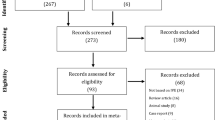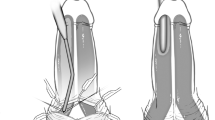Abstract
This study aimed to evaluate a simplified vasovasostomy procedure that shortens the operative time. This was a retrospective (non-randomized) study of men who underwent bilateral vasectomy and consulted for vasovasostomy (02/2014-08/2016). Eight interrupted sutures were used for one-layer full-thickness vasal anastomosis over a 20 or 22 G catheter temporarily inserted in the lumen of the anastomotic site as a stent. Control patients underwent double-layer vasovasostomy. The surgery was significantly shorter in the one-layer group (n = 23) (62 ± 8 vs. 133 ± 15 min, P < 0.001 vs. the two-layer group, (n = 19)). There was no difference in patency between the two groups (95.7 vs. 94.7%, P > 0.999). There was one case of epididymitis in each group. There were no complications like bleeding, scrotal hematoma, hydrocele, or infection. Low-power microscopic one-layer vasovasostomy with stent was simple and had a short operation time. The patency could be similar to that of two-layer vasovasostomy, but prospective studies are necessary for confirmation.
This is a preview of subscription content, access via your institution
Access options
Subscribe to this journal
Receive 8 print issues and online access
$259.00 per year
only $32.38 per issue
Buy this article
- Purchase on Springer Link
- Instant access to full article PDF
Prices may be subject to local taxes which are calculated during checkout


Similar content being viewed by others
References
Ostrowski KA, Holt SK, Haynes B, Davies BJ, Fuchs EF, Walsh TJ. Evaluation of vasectomy trends in the United States. Urology. 2018;118:76–79.
Hamdy FC, Eardley I. Oxford textbook of urological surgery. New York: Oxford University Press; 2017.
Cook LA, Pun A, Gallo MF, Lopez LM, Van Vliet HA. Scalpel versus no-scalpel incision for vasectomy. Cochrane Database Syst Rev. 2014;2014:CD004112.
Zeng Y, Hesketh T. The effects of China’s universal two-child policy. Lancet. 2016;388:1930–8.
Herrel L, Hsiao W. Microsurgical vasovasostomy. Asian J Androl. 2013;15:44–48. https://doi.org/10.1002/14651858.CD004112.pub4.
Sandlow JI, Nagler HM. Vasectomy and vasectomy reversal: important issues. Preface. Urol Clin North Am. 2009;36:xiii–xiv.
Silber SJ. Microsurgery in clinical urology. Urology. 1975;6:150–3.
French DB, Sabanegh E. Advances in microsurgery and assisted reproduction for management of male infertility. Front Biosci. 2009;1:381–9.
Rimar K, Trost L, Brannigan RE. Vasovasostomy techniques for microsurgery specialists. In: Sandlow JI, (Ed.). Microsurgery for fertility specialists—a practical text. New York: Springer Science+Business Media; 2012.
Patel AP, Smith RP. Vasectomy reversal: a clinical update. Asian J Androl. 2016;18:365–71.
Belker AM, Thomas AJ Jr., Fuchs EF, Konnak JW, Sharlip ID. Results of 1469 microsurgical vasectomy reversals by the Vasovasostomy Study Group. J Urol. 1991;145:505–11.
Goldstein M, Li PS, Matthews GJ. Microsurgical vasovasostomy: the microdot technique of precision suture placement. J Urol. 1998;159:188–90.
Hernandez J, Sabanegh ES. Repeat vasectomy reversal after initial failure: overall results and predictors for success. J Urol. 1999;161:1153–6.
Nalesnik JG, Sabanegh ES Jr. Vasovasostomy: multiple children and long-term pregnancy rates. Curr Surg. 2003;60:348–50.
Marks SHF. Vasectomy reversal: manual of vasovasostomy and vasoepididymostomy. 1st ed. Cham, Switzerland: Springer Nature; 2019.
Lee JY, Chang JS, Lee SH, Ham WS, Cho HJ, Yoo TK, et al. Efficacy of vasectomy reversal according to patency for the surgical treatment of postvasectomy pain syndrome. Int J Impot Res. 2012;24:202–5.
Fischer MA, Grantmyre JE. Comparison of modified one- and two-layer microsurgical vasovasostomy. BJU Int. 2000;85:1085–8.
Dickey RM, Pastuszak AW, Hakky TS, Chandrashekar A, Ramasamy R, Lipshultz LI. The evolution of vasectomy reversal. Curr Urol Rep. 2015;16:40.
Nyame YA, Babbar P, Almassi N, Polackwich AS, Sabanegh E. Comparative cost-effectiveness analysis of modified 1-layer versus formal 2-layer vasovasostomy technique. J Urol. 2016;195:434–8.
Herrel LA, Goodman M, Goldstein M, Hsiao W. Outcomes of microsurgical vasovasostomy for vasectomy reversal: a meta-analysis and systematic review. Urology. 2015;85:819–25.
Hsieh ML, Huang HC, Chen Y, Huang ST, Chang PL. Loupe-assisted vs microsurgical technique for modified one-layer vasovasostomy: is the microsurgery really better? BJU Int. 2005;96:864–6.
Jee SH, Hong YK. One-layer vasovasostomy: microsurgical versus loupe-assisted. Fertil Steril. 2010;94:2308–11.
Shessel FS, Lynne CM, Politano VA. Use of exteriorized stents in vasovasostomy. Urology. 1981;17:163–5.
Safarinejad MR, Lashkari MH, Asgari SA, Farshi A, Babaei AR. Comparison of macroscopic one-layer over number 1 nylon suture vasovasostomy with the standard two-layer microsurgical procedure. Hum Fertil. 2013;16:194–9.
Vrijhof EJ, de Bruine A, Zwinderman A, Lycklama a Nijeholt AA, Koole L. New nonabsorbable stent versus a microsurgical procedure for vasectomy reversal: evaluating tissue reactions at the anastomosis in rabbits. Fertil Steril. 2005;84:743–8.
Acknowledgements
This work was supported by the 2015 Basic Research Project (Grant No. JCYJ20150403101028174) of Shenzhen Commission on Science and Technology Innovation and Sanming Project of Medicine in Shenzhen and the 2015 Engineering Center Project (Grant No. GCZX2015043016165448). The funding source(s) had no involvement in study design, collection, analysis, and interpretation of data, and writing of the report
Author information
Authors and Affiliations
Contributions
BW and HJ conceived the study, participated in its design, and performed the surgical procedures and data acquisition. ZL drafted and revised the manuscript. All authors read and approved the final manuscript.
Corresponding author
Ethics declarations
Conflict of interest
The authors declare that they have no conflict of interest.
Additional information
Publisher’s note Springer Nature remains neutral with regard to jurisdictional claims in published maps and institutional affiliations.
Rights and permissions
About this article
Cite this article
Wang, B., Liu, Z. & Jiang, H. Comparison of low-power magnification one-layer vasovasostomy with stent and microscopic two-layer vasovasostomy for vasectomy reversal. Int J Impot Res 32, 617–622 (2020). https://doi.org/10.1038/s41443-019-0216-x
Received:
Revised:
Accepted:
Published:
Issue Date:
DOI: https://doi.org/10.1038/s41443-019-0216-x



